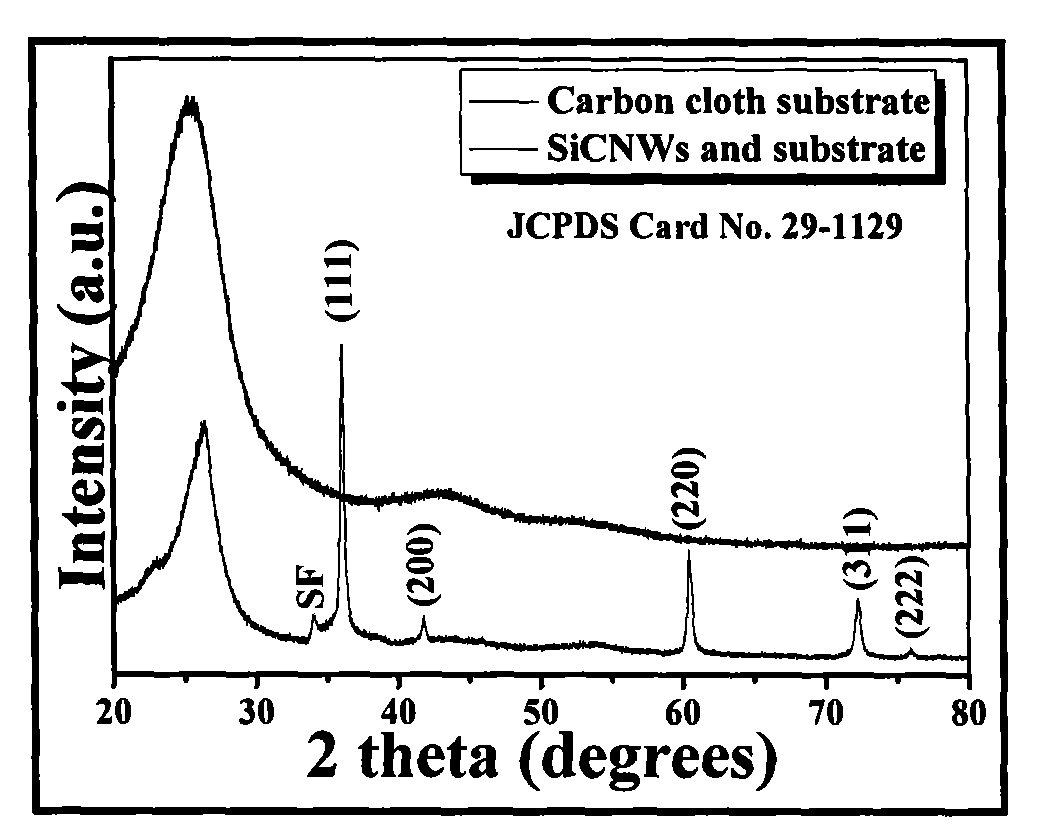SiC flexible field emission cathode material
A field emission cathode and field emission technology, applied in cold cathode manufacturing, electrode system manufacturing, electrical components, etc., can solve the problems of the research and development of flexible field emission cathode materials that are rarely reported in literature, and achieve excellent field emission performance and high flexibility. Effect
- Summary
- Abstract
- Description
- Claims
- Application Information
AI Technical Summary
Problems solved by technology
Method used
Image
Examples
Embodiment 1
[0032] The initial raw material is polysilazane, in N 2 Under the protection of the atmosphere, heat preservation at 260°C for 30 minutes for thermal crosslinking and curing. The solidified SiCN solid was put into a nylon resin ball mill jar, ball milled and pulverized into powder, and 300 mg was weighed and placed at the bottom of a graphite crucible. Cut carbon cloth 5×5cm (length×width), at 0.05mol / LCo(NO 3 ) 3 Immerse in ethanol solution and sonicate for 10 seconds, take it out and let it dry naturally in air environment. The impregnated carbon is arranged on the top of the graphite crucible and placed in an atmosphere sintering furnace heated by graphite resistance. The atmosphere furnace is first evacuated to 10 -4 Pa, refill N 2 :Ar=5:95 nitrogen-argon gas mixture (volume ratio, purity 99.99%), until the pressure is one atmosphere (~0.11Mpa), and then the pressure is constant. Then the temperature was raised rapidly from room temperature to 1400°C at a rate of 40°...
Embodiment 2
[0034] The initial raw material is polysilazane, in N 2 Under the protection of the atmosphere, heat preservation at 260°C for 30 minutes for thermal crosslinking and curing. The solidified SiCN solid was put into a nylon resin ball mill jar, ball milled and pulverized into powder, and 300 mg was weighed and placed at the bottom of a graphite crucible. Cut carbon cloth 5×5cm (length×width), at 0.05mol / LCo(NO 3 ) 3 Immerse in ethanol solution and sonicate for 10 seconds, take it out and let it dry naturally in air environment. The impregnated carbon is arranged on the top of the graphite crucible and placed in an atmosphere sintering furnace heated by graphite resistance. The atmosphere furnace is first evacuated to 10 -4 Pa, refill N 2:Ar=5:95 nitrogen-argon gas mixture (volume ratio, purity 99.99%), until the pressure is one atmosphere (~0.11Mpa), and then the pressure is constant. Then rapidly raise the temperature from room temperature to 1450°C at a rate of 40°C / min,...
Embodiment 3
[0036] The initial raw material is polysilazane, in N 2 Under the protection of the atmosphere, heat preservation at 260°C for 30 minutes for thermal crosslinking and curing. The solidified SiCN solid was put into a nylon resin ball mill jar, ball milled and pulverized into powder, and 300 mg was weighed and placed at the bottom of a graphite crucible. Cut carbon cloth 5×5cm (length×width), at 0.05mol / LCo(NO 3 ) 3 Immerse in ethanol solution and sonicate for 10 seconds, take it out and let it dry naturally in air environment. The impregnated carbon is arranged on the top of the graphite crucible and placed in an atmosphere sintering furnace heated by graphite resistance. The atmosphere furnace is first evacuated to 10 -4 Pa, refill N 2 : Ar=10:90 nitrogen-argon gas mixture (volume ratio, purity 99.99%), until the pressure is one atmospheric pressure (~0.11Mpa), and then the pressure is constant. Then rapidly raise the temperature from room temperature to 1400°C at a rate...
PUM
 Login to View More
Login to View More Abstract
Description
Claims
Application Information
 Login to View More
Login to View More - R&D
- Intellectual Property
- Life Sciences
- Materials
- Tech Scout
- Unparalleled Data Quality
- Higher Quality Content
- 60% Fewer Hallucinations
Browse by: Latest US Patents, China's latest patents, Technical Efficacy Thesaurus, Application Domain, Technology Topic, Popular Technical Reports.
© 2025 PatSnap. All rights reserved.Legal|Privacy policy|Modern Slavery Act Transparency Statement|Sitemap|About US| Contact US: help@patsnap.com



